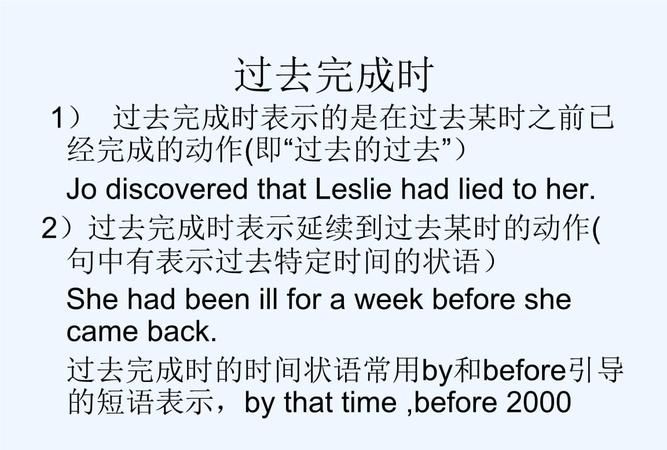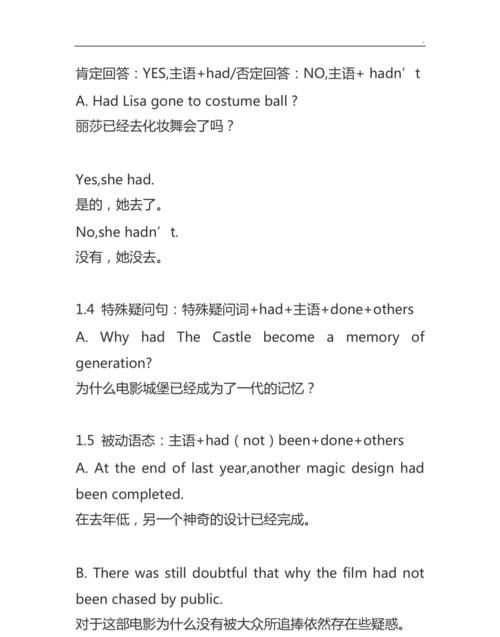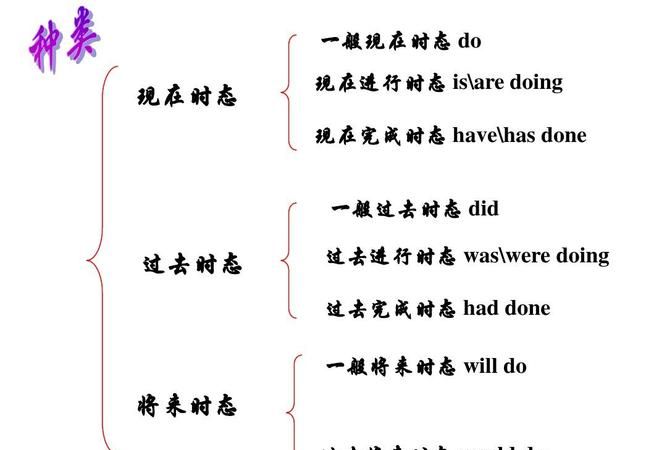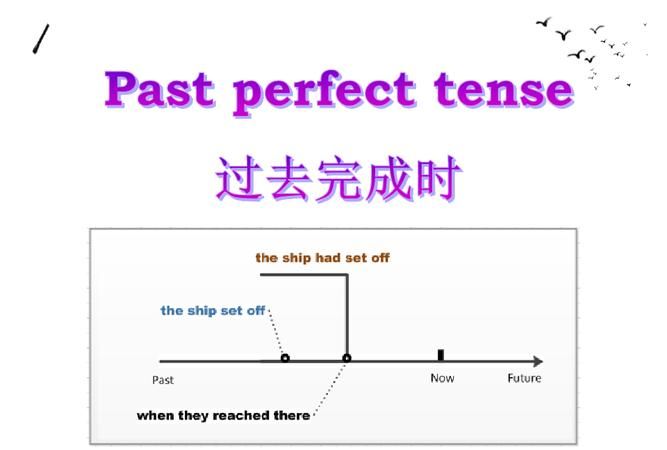本文目录
过去式 过去完成时 现在完成时 的用法
1、表示在过去某一时刻或动作之前完成了的动作,即句子中的动作发生在“过去的过去”。可以用by,before等介词短语或一个时间状语从句来表示。
比如:Lily had just left when we arrived。
2、表示从过去的某一时刻开始,一直延续到过去另一时间的动作或状态,常和for, since构成的时间状语连用。
比如:He had lived in the house for five years .
3、在含有定语从句的主从复合句中,如果叙述的是过去发生的事情,先发生的动作常用过去完成时。
比如:I had returned the English book that I had borrowed from the library.
4、过去完成时还可用在hardly…when…, no sooner…than…, It was the first (second, etc) time (that)…等固定句型中。在这类句型中,要注意,有时会用到倒装语句。
It was the second time that she had been late.

英语语法:过去完成时常见的13种句型
定义:表示在过去某一时刻以前已经完成的动作,或者表示一个动作在另一个过去动作之前就已经完成。
概念:表示过去的过去
----|-------|-----|---->其构成是had
+过去分词构成。
那时以前
那时 现在
用法
a. 在told,
said,
knew,
heard,
thought等动词后的宾语从句。
She
said
(that)
she
had
never
been
to
Paris.
b.
状语从句
在过去不同时间发生的两个动作中,发生在先,用过去完成时;发生在后,用一般过去时。
When
the
police
arrived,
the
thieves
had
run
away.
c.
表示意向的动词,如hope,
wish,
expect,
think,
intend,
mean,
suppose等,用过去完成时表示"原本…,未能…"
We
had
hoped
that
you
would
come,
but
you
didn't.
过去完成时的时间状语before,
by,
until
,
when,
after,
once,
as
soon
as。
He
said
that
he
had
learned
some
English
before.
By
the
time
he
was
twelve,
Edison
had
began
to
make
a
living
by
himself.
Tom
was
disappointed
that
most
of
the
guests
had
left
when
he
arrived
at
the
party
★注意★:如果时间状语从句的动作发生在前,则从句用过去完成时,主句用一般过去时。
When
he
had
finished
his
work
,
he
left
his
office
.
After
I
had
done
my
homework
,
I
went
to
bed.
过去完成时常用于以下固定句型:
1>
no
sooner
+过去完成时+
than
+过去式
例如:No
sooner
had
I
gone
out
than
he
came
to
see
me.
我刚出去,他就来找我。
2>
by
(the
end
of
)
+过去时间,主句中谓语动词用过去完成时
例如:The
experiment
had
been
finished
by
4
o’clock
yesterday
afternoon.
这个实验昨天下午四点前就完成了。
典型例题:
When
we
got
to
the
station,
the
train
A.
left
B.
leaves
C.
has
left
D.
had
left
此题答案是D.
leave为终止性动词,为什么可用过去完成时?什么时用,什么时不用?
当句子出现两个动词时,完成时强调该动作发生在另外一个动作之前。如果两个动作同时发生,则均用现在时或均用过去时。
译文:当我们到达车站时,火车已经开走了。
The
students
___
busily
when
Miss
Brown
went
to
get
a
book
she
___
in
the
office.
A.
had
written,
left B,were
writing,
has
left
C.
had
written,
had
left D.
were
writing,
had
left
答案D.
"把书忘在办公室"发生在"去取书"这一过去的动作之前,因此"忘了书"这一动作发生在过去的过去,用过去完成时。句中when表示的是时间的一点,表示在"同学们正忙于……"这一背景下,when所引导的动作发生。因此
前一句应用过去进行时。
注意: had
no
…
when 还没等……
就……
had
no
sooner…
than 刚……
就……
He
had
no
sooner
bought
the
car
than
he
sold
it.
最简单的方法就是,要用过去完成时的前提是句子有暗示,此动作已经是发生在过去的过去,否则一般情况,都只是用一般过去式

过去完成时的基本结构和用法
过去完成时(Past Perfect Tense)是英语中用来表示过去某个时间之前已经完成的动作或状态。它通常用来表示两个过去动作之间的先后关系,或者表示过去某个时间之前已经完成的动作。
过去完成时的句型结构如下:
主语 + had + 动词过去分词 + ……
例如:
"I had finished my homework before I watched TV." (我完成家庭作业之后才看电视)

过去完成时的基本句型结构
过去完成时的一个基本句的型:He had finished before you finished.
过去完成时通常会参照一个过去的动作,指的是比这个过去动作更早的动作
你是几年级的?

以上就是关于过去完成时的固定句型,过去式 过去完成时 现在完成时 的用法的全部内容,以及过去完成时的固定句型 的相关内容,希望能够帮到您。
